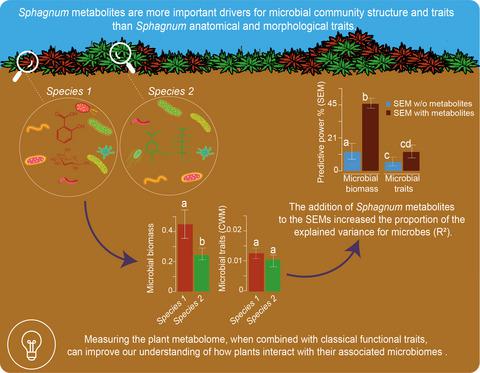Our official English website, www.x-mol.net, welcomes your feedback! (Note: you will need to create a separate account there.)
Predicting the structure and functions of peatland microbial communities from Sphagnum phylogeny, anatomical and morphological traits and metabolites
Journal of Ecology ( IF 5.5 ) Pub Date : 2021-06-12 , DOI: 10.1111/1365-2745.13728 Anna Sytiuk 1 , Regis Céréghino 1 , Samuel Hamard 1 , Frédéric Delarue 2 , Amélie Guittet 2 , Janna M. Barel 1 , Ellen Dorrepaal 3 , Martin Küttim 4 , Mariusz Lamentowicz 5 , Bertrand Pourrut 1 , Bjorn J.M. Robroek 6, 7 , Eeva‐Stiina Tuittila 8 , Vincent E.J. Jassey 1
中文翻译:

从泥炭藓系统发育、解剖学和形态学特征及代谢物预测泥炭地微生物群落的结构和功能
更新日期:2021-07-12
Journal of Ecology ( IF 5.5 ) Pub Date : 2021-06-12 , DOI: 10.1111/1365-2745.13728 Anna Sytiuk 1 , Regis Céréghino 1 , Samuel Hamard 1 , Frédéric Delarue 2 , Amélie Guittet 2 , Janna M. Barel 1 , Ellen Dorrepaal 3 , Martin Küttim 4 , Mariusz Lamentowicz 5 , Bertrand Pourrut 1 , Bjorn J.M. Robroek 6, 7 , Eeva‐Stiina Tuittila 8 , Vincent E.J. Jassey 1
Affiliation

|
- Sphagnum mosses are keystone species in northern peatlands. Notably, they play an important role in peatland carbon (C) cycling by regulating the composition and activity of microbial communities. However, it remains unclear whether information on Sphagnum phylogeny and/or traits-based composition (i.e. anatomical and morphological traits and metabolites) can be used to predict the structure of microbial communities and their functioning. Here we evaluated whether Sphagnum phylogeny and traits predict additional variation in peatland microbial community composition and functioning beyond what would be predicted from environmental characteristics (i.e. climatic and edaphic conditions).
- We collected Sphagnum and microbial data from five European peatlands distributed along a latitudinal gradient from northern Sweden to southern France. These data allowed us to assess Sphagnum anatomical and morphological traits and metabolites at different sites along changing environmental conditions. Using structural equation modelling (SEM) and phylogenetic distance analyses, we investigated the role of Sphagnum traits in shaping microbial community composition and functioning along with environmental conditions.
- We show that microbial community composition and traits varied independently from both Sphagnum phylogeny and the latitudinal gradient. Specifically, the addition of Sphagnum traits to climatic and edaphic variables to the SEM allowed it to explain a larger proportion of the explained variance (R2). This observation was most apparent for the biomass of decomposers (+42%) and phototrophs (+19%), as well as for growth yield microbial traits (+10%). As such, that Sphagnum metabolites were important drivers for microbial community structure and traits, while Sphagnum anatomical and morphological traits were poor predictors.
- Synthesis. Our results highlight that Sphagnum metabolites are more likely to influence peatland microbial food web structure and functioning than Sphagnum anatomical and morphological traits. We provide further evidence that measurements of the plant metabolome, when combined with classical functional traits, improve our understanding of how the plants interact with their associated microbiomes.
中文翻译:

从泥炭藓系统发育、解剖学和形态学特征及代谢物预测泥炭地微生物群落的结构和功能
- 泥炭藓是北部泥炭地的关键物种。值得注意的是,它们通过调节微生物群落的组成和活动,在泥炭地碳 (C) 循环中发挥着重要作用。然而,尚不清楚有关泥炭藓系统发育和/或基于特征的组成(即解剖和形态特征和代谢物)的信息是否可用于预测微生物群落的结构及其功能。在这里,我们评估了泥炭藓系统发育和特征是否预测了泥炭地微生物群落组成和功能的额外变化,超出了环境特征(即气候和土壤条件)的预测。
- 我们从沿着从瑞典北部到法国南部的纬度梯度分布的五个欧洲泥炭地收集了泥炭藓和微生物数据。这些数据使我们能够根据环境条件的变化评估不同地点的泥炭藓解剖学和形态学特征和代谢物。使用结构方程模型 (SEM) 和系统发育距离分析,我们研究了泥炭藓特征在塑造微生物群落组成和功能以及环境条件中的作用。
- 我们表明微生物群落组成和性状独立于泥炭藓系统发育和纬度梯度而变化。具体而言,将泥炭藓特征添加到 SEM 的气候和土壤变量使其能够解释更大比例的解释方差 ( R 2 )。这种观察对于分解者 (+42%) 和光养生物 (+19%) 的生物量以及生长产量微生物性状 (+10%) 最为明显。因此,泥炭藓代谢物是微生物群落结构和性状的重要驱动因素,而泥炭藓解剖学和形态学特征是较差的预测因子。
- 合成。我们的结果强调,与泥炭藓解剖和形态特征相比,泥炭藓代谢物更有可能影响泥炭地微生物食物网结构和功能。我们提供了进一步的证据,表明植物代谢组的测量与经典功能特征相结合,可以提高我们对植物如何与其相关微生物组相互作用的理解。


























 京公网安备 11010802027423号
京公网安备 11010802027423号